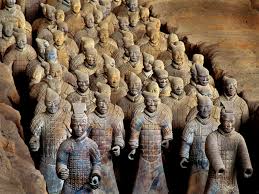
The Terracotta Army
An Introduction to the Terracotta Army
The Terracotta Army is a collection of terracotta sculptures depicting the armies of Qin Shi Huang, the first emperor of China. It is a form of funerary art buried with the emperor in 210–209 BCE with the purpose of protecting the emperor in his afterlife.
Located at the foot of Mount Li, 30 kilometers east of Xi’an, Shaanxi province, China, the Terracotta Army is part of the larger mausoleum complex of the first Qin emperor. It is considered one of the greatest archaeological discoveries of the 20th century, and a UNESCO World Heritage Site.
The majority of the figures in the pits are warriors, and they are arranged in battle formations, with infantry, cavalry, and charioteers. The figures are life-sized and highly realistic, with individual facial features, hairstyles, and armor. Originally, they were painted in bright colors, but most of the paint has faded over the centuries.
The construction of the Terracotta Army was a massive undertaking, involving the labor of thousands of workers over many years. The figures were made using local clay, and they were fired in kilns at high temperatures. The creation of the Terracotta Army is a testament to the skill and artistry of ancient Chinese craftsmen, as well as the power and ambition of the Qin dynasty.
The Story of the Terracotta Army
According to legend, after Qin Shi Huang unified the six kingdoms of China, he became obsessed with the idea of immortality. He ordered the construction of a lavish tomb for himself, complete with an army of terracotta warriors to protect him in the afterlife. The construction of the tomb and the terracotta army took decades and involved the labor of hundreds of thousands of workers. It is said that the workers who created the terracotta army were buried alive with the emperor to protect the secrets of their creation.
The use of terracotta figures to represent an army was not unique to the Qin dynasty. However, the scale and realism of the Terracotta Army is unparalleled. It is believed that the figures were modeled after real soldiers, and their armor and weapons were carefully crafted to be as lifelike as possible. The Terracotta Army provides valuable insights into the military organization, weaponry, and culture of the Qin dynasty.
For centuries, the Terracotta Army lay forgotten beneath the earth. In 1974, a group of farmers digging a well stumbled upon one of the pits containing the terracotta figures. The discovery made headlines around the world and sparked a wave of archaeological excavation. Since then, thousands of terracotta figures have been unearthed, along with weapons, chariots, and other artifacts.
The Mystery of the Missing Weapons
One of the enduring mysteries surrounding the Terracotta Army is the disappearance of the weapons that the warriors once held. When the figures were first discovered, many of them still had bronze weapons in their hands. However, over time, it became clear that most of these weapons had been looted. The identity of the looters and the fate of the missing weapons remain a subject of speculation.
Some believe that the weapons were stolen by tomb robbers in the centuries after Qin Shi Huang's death. Others speculate that the weapons were removed by rebels who overthrew the Qin dynasty. Still others believe that the weapons were never actually placed in the hands of the terracotta warriors, and that the figures were intended to be symbolic rather than practical.
The mystery of the missing weapons adds to the intrigue of the Terracotta Army, which continues to captivate visitors from around the world. It is a reminder of the vastness of history and the many secrets that still lie hidden beneath the earth.
FAQs about the Terracotta Army
Q: How many terracotta warriors are there?
A: It is estimated that there are over 8,000 terracotta warriors in the three pits that have been excavated so far.
Q: How were the terracotta warriors made?
A: The terracotta warriors were made using a process called piece-mold casting. First, a model of the figure was made out of clay. Then, molds were created from the model, and these molds were used to create the individual parts of the figures. The parts were then assembled and fired in a kiln.
Q: Why are the terracotta warriors so famous?
A: The Terracotta Army is famous for its size, realism, and historical significance. It is a unique and impressive example of ancient Chinese art and craftsmanship. The Terracotta Army provides valuable insights into the military organization, weaponry, and culture of the Qin dynasty. It is a reminder of the power and ambition of one of China's most famous rulers.